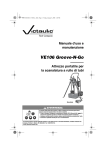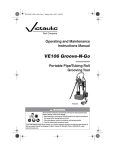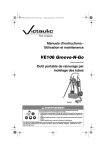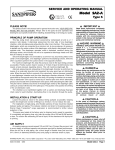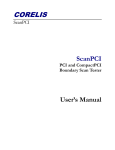Download Victaulic HCT908 Product specifications
Transcript
R Operating and Maintenance Instructions Manual HCT908 Variable Speed Hole-Cutting Tool • Before operating or servicing the HCT908 Hole-Cutting Tool, read all instructions in this manual and all warning labels on the tool. • Always wear safety glasses, hardhat, foot protection, and hearing protection. • Save this operating and maintenance manual. Failure to follow instructions and warnings can result in serious personal injury, property damage, and/or product damage. If you need additional copies of any literature, or if you have any questions about the safe operation of this tool, contact Victaulic Tool Company, 1326 Tatamy Road, Easton, PA 18042, Phone: 610-559-3300. Victaulic® Tool Company • 1326 Tatamy Road • Easton, PA 18045 • 1-800-PICK VIC • FAX: 610-250-7065 ® Registered Trademark of Victaulic © Copyright 2000 Victaulic Printed in U.S.A. HCT908 INDEX Hazard Identification. . . . . . . . . . . . . . . . .2 Operator Safety Instructions . . . . . . . . . .3 Introduction . . . . . . . . . . . . . . . . . . . . . . . .4 Installing the Hole Saw onto the Arbor Assembly. . . . . . . . . . . . . . . . . . . . .6 Tool Setup and Operation . . . . . . . . . . . . .6 Removing the Hole Saw from the Arbor Assembly. . . . . . . . . . . . . . . . . . . . .9 Receiving Tool . . . . . . . . . . . . . . . . . . . . . .4 Maintenance . . . . . . . . . . . . . . . . . . . . . .10 Tool Nomenclature . . . . . . . . . . . . . . . . . .4 Accessories . . . . . . . . . . . . . . . . . . . . . . .11 Power Requirements. . . . . . . . . . . . . . . . .5 Troubleshooting. . . . . . . . . . . . . . . . . . . .12 HAZARD IDENTIFICATION Definitions for identifying the various hazard levels are provided below. This safety alert symbol indicates important safety messages. When you see this symbol, be alert to the possibility of personal injury. Carefully read and fully understand the message that follows. The use of the word “DANGER” identifies an immediate hazard with a likelihood of death or serious personal injury if instructions, including recommended precautions, are not followed. NOTICE The use of the word “NOTICE” identifies special instructions that are important but not related to hazards. 2 The use of the word “WARNING” identifies the presence of hazards or unsafe practices that could result in death or serious personal injury if instructions, including recommended precautions, are not followed. HCT908 OPERATOR SAFETY INSTRUCTIONS The HCT-908 is designed only for cutting holes in steel and stainless steel pipe. Using this tool requires dexterity and mechanical skills, as well as sound safety habits. Although this tool is manufactured for safe, dependable operation, it is impossible to anticipate those combinations of circumstances that could result in an accident. The following instructions are recommended for safe operation of this tool. The operator is cautioned to always practice “safety first” during each phase of use, including setup and maintenance. 1. Read this manual before operating or servicing this tool. Become familiar with the tool’s operations, applications, and limitations. Be particularly aware of its specific hazards. Store this manual in a clean area where it is always readily available. Additional copies of this manual are available upon request by calling or writing to the Victaulic Tool Company. 2. Avoid using the tool in dangerous environments. Do not expose the tools to rain, and do not use the tools in damp or wet locations. Do not cut holes into pressurized pipe or pipe that is filled with water, other fluid, or compressed gas. Keep the work area well lit. 3. Do not operate tools in gaseous or explosive environments. The motors in these tools produce a normal spark, which could ignite fumes. 4. Ground all tools to protect the operator from electric shock. 5. Inspect the equipment. Before starting the tool, check the moveable parts for any obstructions. Make sure that the tool’s parts are installed and secured properly. 6. Wear proper apparel. Do not wear loose clothing or jewelry, and keep long hair tied back. 7. Wear protective items when working with tools. Always wear safety glasses, hardhat, foot protection, and hearing protection. A face or dust mask may be necessary if the cutting operation produces fine particles. 8. Stay alert. Do not operate the tool if you are drowsy from medication or fatigue. Avoid horseplay around the equipment. 9. Keep visitors away from the immediate work area. All visitors should be kept a safe distance from the equipment at all times. 10. Secure work. Use clamps or a vise to hold work. 11. Do not overreach. Maintain proper footing and balance at all times. 12. Remove adjustment keys and wrenches from the tool. Always check to make sure adjustment keys and wrenches are removed from the tool before operation. 13. Keep work areas clean. Keep the work area around the tool clear of obstructions that could limit the movement of the operator. Clean up all oil and coolant spills. Remove shavings from the tool to maintain proper operation. 14. Avoid accidental starting. Do not carry the plugged-in tool with your finger on the trigger. 15. Use proper extension cords for outdoor use. When using the tool outdoors, use only extension cords marked suitable for outdoor use. 16. Do not force the tool. Do not force a smaller tool or attachment to do the job of a heavy-duty tool. 17. Do not abuse the power cord. Never carry the tool by the cord or yank it out of the receptacle. Keep the cord away from heat, oil, and sharp objects. 18. Maintain tools with care. Keep tools sharp and clean at all times to ensure the best and safest performance. Follow the instructions for lubricating and changing accessories. 19. Disconnect tools when not in use. Always disconnect tools when not in use; before servicing; when changing accessories, such as blades, arbors, and chucks; and before removing the coupon from the hole saw. 20. Store idle tools. When tools are not in use, store them in a dry, secure place. 21. Disconnect power cord before servicing the tool. Only authorized personnel should attempt to change hole saws and perform maintenance on the tools. Always disconnect the power cord before servicing or making any adjustments. 22. Use only Victaulic replacement parts and accessories. Use of any other parts may result in improper operation and hazardous situations. 3 HCT908 NOTICE Drawings and/or pictures in this manual may be exaggerated for clarity. INTRODUCTION The Victaulic HCT908 Variable Speed Hole-Cutting Tool is specifically designed to cut holes in steel and stainless steel pipe for branch connections using Victaulic Hole Cut Products. This tool is not designed for use on cast iron or PVC pipe. The HCT908 is suitable for 1¹⁄₄ - 8-inch (42,4 - 219,1-mm) pipe sizes and can cut up to 4¹⁄₂-inch (115-mm) hole sizes. RECEIVING TOOL Upon receipt of the tool, check to make sure all necessary parts are included. If the shipping container does not contain the correct components, contact Victaulic Tool Company. NOTE: If the tool is rented, save the shipping container for return shipment. Quantity Description 1 Drill Motor Assembly with Chuck Key 1 Extra Pilot Drill with Coupon Saver 1 Arbor Assembly 1 Coupon Removal Tool 2 Instruction Manuals 1 Shipping Container NOTE: Hole saws must be ordered separately. Permanent carrying case is available and can be ordered separately. TOOL NOMENCLATURE Speed Control Dial (on topside of Drill Motor Handle) Feeder Knob Drill Motor Handle Drill Motor Power Cord Bearing Feeder Rod Trigger Chuck Key (attached to power cord) Vise Handle Chuck Base Coupon Removal Tool 4 Chain Slot Arbor Assembly Chain HCT908 POWER REQUIREMENTS • To reduce the risk of electric shock, make sure the electrical source is properly grounded, and follow all instructions carefully. • Before performing any maintenance on the tool, disconnect it from the electrical source. • Always unplug tool after each use. Failure to follow these instructions could result in death or serious personal injury. The tool is equipped with a three-prong plug and must be plugged into a grounded, single-phase electrical receptacle (Figure A below). If an adapter is used to accommodate the three-prong plug, the adapter’s wire must be attached to a known ground (refer to Figures A and B and power supply chart below). Never remove the third prong. ➥ ADAPTER ➥ ➥ ➥ GROUNDING PRONG IS LONGEST OF THE 3 PRONGS GROUNDED OUTLET BOX Figure A METAL SCREW ➥ GROUNDED OUTLET BOX ➥ Figure B GROUNDING MEANS Figure C NOTICE • The tool is equipped with a UL Listed three-conductor cord and three-prong grounding type plug to fit the proper, grounding type receptacle. The green (or green and yellow) conductor in the cord is the grounding wire. Never connect the green (or green and yellow) wire to a live terminal. Model volts/(amps) 120 Power Supply Requirements 120 VAC, 15 amp, 50/60 cycle power supply (7) EXTENSION CORD REQUIREMENTS FOR ELECTRICALLY-POWERED TOOLS It is important to use the proper extension cord size (e.g. conductor-sized American Wire Gauge/circular mils) when pre-wired outlets are not available. Cord size selection is based upon tool rating (volts/amps) and cord length (feet/meters). Use of cord size thinner than required will cause a significant voltage drop at the tool while it is operating. The voltage drop may cause damage to the tool and can result in failure of the tool to operate properly. Use of a heavier cord size than required is acceptable. The chart below contains the required cord sizes for cord lengths up to and including 100 feet (30 meters). Avoid using cords beyond 100 feet (30 meters) in length. Recommended Extension Cord Conductor Size at Various Cord Lengths Circuit Rating volts (amps) Cord Length feet (meters) Conductor Size American Wire Gauge (circular mils) 25 12 (8) (6 530) 120 50 12 (15) (15) (6 530) 100 10 (30) (10 380) 5 HCT908 INSTALLING THE HOLE SAW ONTO THE ARBOR ASSEMBLY TOOL SETUP AND OPERATION • DO NOT plug the tool into the electrical source until instructed. Failure to follow this instruction could result in serious personal injury. 1. Ensure that the pipe is secured before attempting to use this hole-cutting tool. 1. Depending on the type of arbor assembly included with the tool, thread or push the locking ring of the arbor assembly back as far as it will go. 2. Locate the center of the hole to be cut on the pipe run. Mark this center point clearly with a punch. NOTICE 2. Thread the hole saw onto the arbor assembly just enough to line up the holes in the top of the hole saw with the drive pins on the arbor assembly. If the pins do not line up with the holes, back off the hole saw just enough to line up the holes with the drive pins 3. Thread or push the locking ring of the arbor assembly all the way down, making sure the pins of the arbor assembly engage the holes in the top of the hole saw. Make sure the hole saw is flush with the arbor assembly and that the hole saw is installed firmly onto the arbor assembly. 6 • When selecting the hole location, take into account the width of the product you are installing. Ensure that it will fit and not interfere with couplings or grooves. Additionally, allow room on the pipe to mount the hole-cutting tool. 3. Place the hole-cutting tool onto the pipe. Hook the chain around the pipe and insert it into the chain slot on the side of the tool’s base. Leave the chain loose enough to allow base movement. HCT908 4. Raise the drill motor to its highest position by rotating the feeder knob counterclockwise. 8. Using the vise handle, tighten the chain around the pipe to secure the hole-cutting tool. • To reduce the risk of electric shock, check the electrical source for proper grounding, and follow the instructions below. Failure to follow these instructions could result in death or serious personal injury. 5. Take the hex-shaped end of the arbor assembly, and insert it into the chuck of the drill’s motor. Switch – shown in forward position Trigger 9. Check the switch on the underside of the drill motor’s handle. Make sure the switch is in the “forward” position, as shown above. 6. Support the arbor assembly, while tightening the chuck securely with the chuck key provided. 7. Align the hole saw’s drill bit with the center punch mark. 10a. Install cord by aligning connector’s keyways. Push connector in as far as it will go. Turn the cord’s nut ¹⁄₄-turn to the right to lock the cord in place. 7 HCT908 10b. Plug the drill motor’s cord into an appropriate outlet or extension cord (refer to “Power Requirements” section on page 5). • NEVER use the HCT908 Hole-Cutting Tool on applications where spark hazards exist or contact with water can occur. Failure to follow this instruction could result in serious personal injury and product damage. Speed Control Dial 11. Set the speed control dial (on the topside of the drill motor’s handle) for the correct application. Refer to the chart below. Hole Saw Size inches (mm) 1 (26 mm) 1¹⁄₄ (32 mm) 1¹⁄₂ (38 mm) 1³⁄₄ (45 mm) 2 (51 mm) 2¹⁄₂ (64 mm) 2³⁄₄ (70 mm) 3¹⁄₂* (89 mm) 4¹⁄₂* (115 mm) Speed Control Setting for Steel Pipe Speed Control Setting for Stainless Steel Pipe 8 3 to 4 8 3 to 4 8 3 to 4 8 3 to 4 8 3 to 4 8 2 to 3 8 2 to 3 3 to 4 3 to 4 3 to 4 3 to 4 NOTE: All of the settings shown to the right are based on using Milwaukee^ 4/6 Super-Tough° BI Metal Hole Saws or Victaulic Hole Saws. * Milwaukee 4/6 Super-Tough Bi-Metal Hole Saws or Victaulic Hole Saws MUST be used for 3¹⁄₂-inch (89 mm) and 4¹⁄₂-inch (115 mm) sizes. ^Milwaukee is a registered trademark of Milwaukee Electric Tool Corporation. °Super-Tough is a registered trademark of Milwaukee Electric Tool Corporation. 8 12. Depress the trigger on the underside of the drill motor’s handle, and feed the hole saw by turning the feeder knob clockwise. Feed the saw into the cut at a moderate rate to maintain good cutting action. DO NOT feed the saw too fast, since it can cause the motor to stall. If difficulties occur during the cutting operation, refer to the “Troubleshooting” section on page 12. 13. After completing the cut, remove your finger from the trigger, and retract the hole saw by turning the feeder knob counterclockwise. NOTICE • To extend hole saw life, apply steel pipe thread cutting oil to the hole while you are performing the cutting operation. • Avoid touching the coupon with your bare hands. Coupons can be very hot and sharp. Failure to follow this instruction could result in serious personal injury. HCT908 14. Unplug the tool from the electrical source. Remove the coupon from the hole saw by using the coupon removal tool, as shown above. Use care not to damage the wire wound into the drill. Remove any chips from the drill. NOTICE • If the coupon fell out of the tool and into the pipe, remove the coupon from inside the pipe. 17. Brush away shavings from around the hole so that the hole-cut product’s gasket can seal properly on the pipe. Use a file, if necessary, to remove burrs or scratches from the gasket sealing area. The pipe surface within ⁵⁄₈" (16 mm) of the hole must be clean, smooth, and free from indentations that might affect gasket sealing. The pipe around the entire circumference within the “A” dimension (refer to chart and illustration above) must be free of any dirt or projections that might prevent the hole-cut product from seating fully on the pipe A ⁵⁄₈" (16 mm) 15. Support the tool. Loosen the vise handle. 16. Continue to support the tool. Unhook the chain from the slot. Remove the tool from the pipe. Branch Size inches (mm) “A” Dimension inches (mm) ¹⁄₂ 3 ¹⁄₂ (21,3) (90) ³⁄₄ 3 ¹⁄₂ (26,9) (90) 1 3 ¹⁄₂ (33,7) (90) 1 ¹⁄₄ 4 (42,4) (100) 1 ¹⁄₂ 4 (48,3) (100) 2 4¹⁄₂ (60,3) (115) 2 ¹⁄₂ 4³⁄₄ (73,0) (120) 76,1 mm 4³⁄₄ (120) 3 5¹⁄₂ (88,9) (140) 4 6¹⁄₂ (114,3) (165) 9 HCT908 LUBRICATION REMOVING THE HOLE SAW FROM THE ARBOR ASSEMBLY The HCT908 Hole-Cutting Tool is lubricated at the factory. However, periodic lubrication of the following parts will maintain smooth and proper operation of the tool. • Always unplug the tool from the electrical source before removing the hole saw from the arbor assembly. Failure to follow this instruction could result in serious personal injury. 1. Lubricate the feeder rod with light oil. 1. Remove the arbor assembly from the drill by using the chuck key provided. 2. Lubricate the bearing with light oil. ADJUSTING THE GIB 2. Depending on the type of arbor assembly included with the tool, pull or thread the locking ring all the way up, making sure the pins in the arbor assembly are completely free from the hole saw. Unscrew the hole saw from the arbor assembly and remove. MAINTENANCE • Before performing any maintenance on the tool, disconnect it from the electrical source. Failure to follow this instruction could result in serious personal injury. 10 After many uses, play may develop at the gib, allowing excessive side-to-side movement of the drill motor assembly. This play is easily corrected by using the screw adjustment provided. 1. Loosen the lock nuts, and adjust the screws to take up any slack (refer to the photo above). 2. Re-tighten the lock nuts while holding the screws in place. Check the side-to-side movement in the assembly. Run the assembly up and down by using the feeder knob, and check for excessive drag. When properly adjusted, very little side-to-side motion will occur, and very little drag will be felt when rotating the feeder knob. HCT908 ARBOR ASSEMBLY FOR 1¹⁄₄-INCH (32-mm) OR LARGER DIAMETER HOLE SAWS ACCESSORIES ARBOR ASSEMBLY FOR 1-INCH (26-mm) DIAMETER HOLE SAW 405 406 407 408 409 411 414 416 417 412 413 415 404 402 402 Item No. Part No. 450 R-450-900-HCT Qty. Description Ref. Arbor Assembly Item No. Part No. 400 R-400-900-HCT Qty. Description Ref. Arbor Assembly1 402 R-402-900-HCT 1 Coupon-Retaining Drill Bit 402 R-402-900-HCT 1 Coupon-Retaining Drill Bit 412 N-M14-000-007 1 Arbor 404 N-S90-050-010 1 Nyloc Half Dog Set Screw 415 N-S90-050-004 1 Nyloc Half Dog Set Screw 405 N-M14-000-025 1 Arbor 413 N-M18-000-011 * Hole Saw 1" (26 mm) 406 N-M18-000-016 * Hole Saw 1¹⁄₄" (32 mm) 407 N-M18-000-021 * Hole Saw 1¹⁄₂" (38 mm) 408 N-M18-000-026 * Hole Saw 1³⁄₄" (45 mm) 409 N-M18-000-031 * Hole Saw 2" (51 mm) 411 N-M18-000-037 * Hole Saw 2¹⁄₂" (64 mm) 414 N-M18-000-040 * Hole Saw 2³⁄₄" (70 mm) 416 N-M18-000-047 * Hole Saw 3¹⁄₂" (89 mm) 417 N-M18-000-050 * Hole Saw 4¹⁄₂" (115 mm) *Hole saws must be ordered separately *Hole saws must be ordered separately. 1 Arbor assembly is supplied with the tool. 11 HCT908 TROUBLESHOOTING PROBLEM POSSIBLE CAUSE SOLUTION Base will not fully tighten onto the pipe. Vise handle has run out of threads. Loosen vise handle and position one link tighter on chain slot. Re-tighten vise handle. Motor will not run. 1) Tool is not plugged in. 2) A fuse is blown, or the circuit breaker is off or tripped. 3) Motor trigger switch is defective. 4) Plug is not making good contact with the receptacle. 5) Tool cord is damaged. 1) Plug the tool into the proper voltage outlet or extension cord. 2) Replace the power supply fuse, or reset the breaker. 3) Replace the motor trigger switch. 4) Inspect the connection and make repairs, as necessary. 5) Replace the tool’s cord. Pilot drill will not cut. 1) Drill motor is running in reverse. 2) Pilot drill is not tight in the arbor. 3) Pilot drill is dull. 1) Move the motor switch to the forward position. 2) Tighten the arbor’s set screw. Make sure it engages the pilot drill’s flats. 3) Replace the pilot drill. Hole saw blade will not cut. 1) Drill motor is running in reverse. 2) Hole saw blade is dull. 3) One or more teeth have been broken off the hole saw blade. 4) Pipe has a hard spot or a hard weld seam. 5) Chips are stuck in the cut. 1) Move the motor switch to the forward position. 2) Replace the hole saw blade. 3) Replace the hole saw blade. Inspect the cut to see if teeth are lodged in the pipe. Remove lodged teeth with a center punch or a small chisel (wear eye protection). 4) Use a sharp hole saw blade and generously lubricate the cut with thread-cutting oil. Cut the hole slowly. 5) Remove chips from the hole saw’s teeth and the cut. Excessive torque is required to rotate the feeder knob. 1) Move the motor switch to the forward position. 1) Drill motor is running in reverse. 2) There is a lack of lubrication on the 2) Lubricate the feeder rod according to the instructions in the “Maintenance” section of this feeder rod. manual. 3) The gib is too tight. 3) Re-adjust the gib according to the instructions in the “Maintenance” section of this manual. Drill motor gets very hot. 1) Holes are being cut too fast. 2) Hole saw blade is dull. 3) An undersized or too long of an extension cord is being used. 1) Feed the hole saw into the cut at a moderate rate, and do not bog down the motor. 2) Replace the hole saw blade. 3) Replace the extension cord with one of the proper size and length (refer to “Power Requirements” section in this manual). Excessive side-to-side play is occurring. Gib is out of adjustment. Adjust the gib, according to the instructions in the “Maintenance” section of this manual. Pilot drill does not retain the coupon. Coupon retaining drill bit is damaged. Replace the pilot drill. Hole saw life is short. Speed control dial is set too high. Set the speed control dial to the recommended setting listed in this manual. Victaulic® Factory Representatives and Distributor Stocks Worldwide Victaulic reserves the right to change product specifications, designs and standard equipment without notice and without obligation. TM-HCT908 12 3022 Rev.B 9/01 RM00908000














